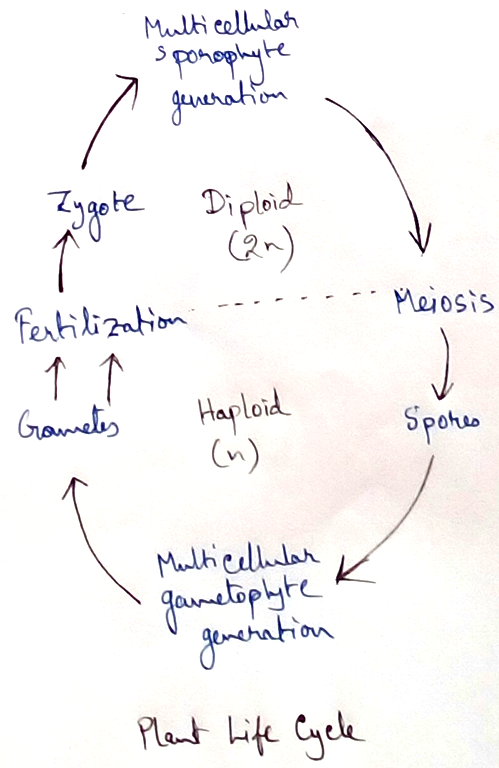Plant Life Cycles and Alternation of Generations
Life cycle of plants: It is recurring morphological cytological phases in an organism that occur in each individual organisms from it’s birth to death.
According to it can be divided into three –
I. Haplobiontic - In this cases there is single somatic phase is present. Again it can be divided into two-
1. Haplontic - It has single somatic phase which is haploid. Diploid condition is present only in zygote or zygospore wherein meiosis occurs to produce haploid condition again. Example of haplontic is mainly algae (Spirogyra, Chlamydomonus, Ulothrix and Chara. Here alteration of generation is absent.
2. Diplontic –In this case single diploid somatic phase is observed. Haploid conditions occurs in gametes which is formed through meiosis and it is fused to restore diploid state. Here alteration of generation is absent. Examples of diplontic are – Cladophora, Bryopsis, Fucus, Sargassum etc.
II. Diplobiontic – Organisms which show diplobiontic life cycle have two somatic phases in their life history.
1. Diplohaplontic: Both haploid gametophyte and diploid sporophytic somatic phases occur in the life history. It has two subtypes. They are-
- Isomorphic or Monomorphic Diplohaplontic- In this case gametophytic and sporophytic phases are morphologically similar though cytologically they are haploid and diploid respectively. There is an isomorphic or homologous alteration of generation. Example of this type are –Ulva, Dictyota.
- Heteromorphic or Dimorphic Diplohaplontic- Haploid and diploid phases are morphologically dissimilar. One of them is dominant. A heterologous or heteromorphic alteration of generation occurs. In some cases gametophytic body is dominant (Bryophyte) and in others sporophytic body is dominant ( pteridophytes).
2. Haplohaplontic – Only haploid cytological stage is observed which contain two somatic phases. They are dimorphic haplobiontic or diphasic haplohaplontic. Example of this is Porphyra.
III. Triplonbiontic – Two types of somatic phases areoccurred. They are-
1. Haplohaplohaplontic – Three haploid phases are occurred in entire life history.
2. Diplodiplohaplontic – Triphasic or trimorphic life history with two diploid and one haploid stages. Example is Polysiphonia.
Plants alteration of generation mean occurrence of conversion of gametophytic stage and sporophytic stage on each other and their dependency in plant life cycle. In some plants sporophyte (2n) is dominant whereas in some plants gametophytic (n) is dominant.
Bryophyte: Bryophyte has haploid gametophyte dominant body. It produced eggs (n) in the archegonium and sperm (n) in antheridium. Sperms need water to swim towards the eggs for fertilization and zygote is produced (2n) which give rise to the sporophytic body (2n). Parasitic sporophyte (depending on female gametophyte) undergoes meiosis division to give rise gametophytes.
Pteridophytes: Sporophytic body is dominant in fern. Diploid cells undergoes meiosis to produce haploid spores (n)which burst out to give rise to haploid organisms and produces gametophyte.After maturation haploid organisms create haploid egg and sperm which fuse together to produce sporophyte.
Other plants have diploid dominant body and haploid gametes give birth to the diploid new plant.
Question and answer on Plant Life Cycles and Alternation of Generations:
What is hypnozygote?
Most of the green algae have a haplontic life cycle. The zygote nucleus is being the only diploid nucleus in this type of life cycle. The zygote becomes thick walled and germination occurs after a period of obligate dormancy. This thick walled zygote is called hypnozygote.
From Plant Life Cycle to HOME PAGE
Recent Articles
-
What Is Plasma? | Blood Plasma | Proteins | Nutrients | Cholesterol
Nov 07, 25 10:29 AM
Blood is a mobile fluid which is a connective tissue and is derived from the mesoderm like cell any other connective tissue. Colour of blood is reddish and that flows inside the blood vessels by means… -
Disorders of Respiratory System | Tuberculosis | Pleurisy | Emphysema
Oct 28, 25 11:39 PM
Tuberculosis is very common disease and is caused by a type of bacteria called Mycobacterium tuberculosis. This disease causes different trouble in the respiration and infection of several parts of th… -
Regulation of Respiration | Respiratory Centres | Inspiratory Area |
Oct 14, 25 12:13 AM
Respiratory Centre is the area that controls the rate of respiration and it is observed to be located in medulla oblongata and pons. Respiratory Centre has the following will dispersed components like… -
Explain Transport of Gases | External Respiration | Tissue Respiration
Oct 09, 25 11:35 PM
In humans gaseous exchange is completed in the following ways the steps are - External Respiration or Breathing - Breathing in false taking in of Oxygen and giving out of carbon dioxide in the body. M… -
Kind and Number of Teeth | Location of Teeth in Mouth | Care of Teeth
Sep 11, 25 12:52 AM
Kind and Number of Teeth






New! Comments
Have your say about what you just read! Leave me a comment in the box below.